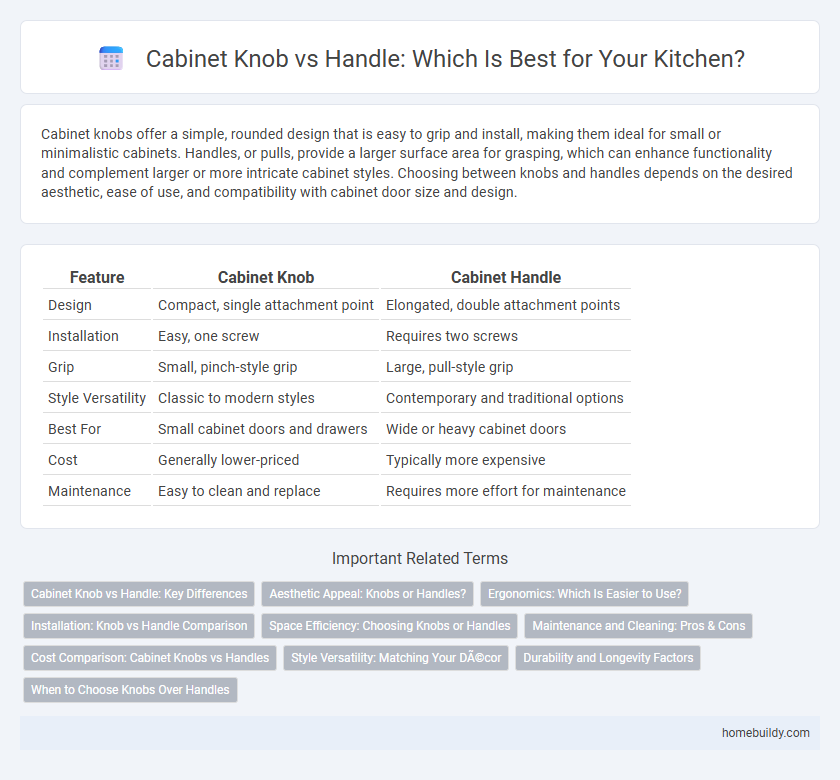Cabinet knobs offer a simple, rounded design that is easy to grip and install, making them ideal for small or minimalistic cabinets. Handles, or pulls, provide a larger surface area for grasping, which can enhance functionality and complement larger or more intricate cabinet styles. Choosing between knobs and handles depends on the desired aesthetic, ease of use, and compatibility with cabinet door size and design.
Table of Comparison
| Feature | Cabinet Knob | Cabinet Handle |
|---|---|---|
| Design | Compact, single attachment point | Elongated, double attachment points |
| Installation | Easy, one screw | Requires two screws |
| Grip | Small, pinch-style grip | Large, pull-style grip |
| Style Versatility | Classic to modern styles | Contemporary and traditional options |
| Best For | Small cabinet doors and drawers | Wide or heavy cabinet doors |
| Cost | Generally lower-priced | Typically more expensive |
| Maintenance | Easy to clean and replace | Requires more effort for maintenance |
Cabinet Knob vs Handle: Key Differences
Cabinet knobs are typically small, round fixtures that require only one screw for installation, offering a minimalist and versatile design compared to cabinet handles, which are typically elongated and secured with two screws for greater grip. Knobs provide a simpler grip and are often favored for their ability to blend seamlessly with various cabinet styles, while handles offer enhanced leverage and ease of use, especially on larger cabinet doors and drawers. The choice between cabinet knobs and handles depends on factors such as aesthetic preference, ergonomic comfort, and the functional demands of the cabinetry.
Aesthetic Appeal: Knobs or Handles?
Cabinet knobs offer a minimalist and symmetrical aesthetic that complements both modern and traditional cabinetry, creating a balanced visual focal point without overwhelming the design. Handles, with their elongated shape, tend to provide a more pronounced and dynamic look that can emphasize the horizontal or vertical lines of the cabinets. Choosing between a knob and a handle depends on the desired aesthetic impact: knobs maintain subtle elegance, while handles deliver a bolder, statement-making appeal.
Ergonomics: Which Is Easier to Use?
Cabinet knobs offer a simple grip that suits smaller hands and light pulling motions, making them ergonomically friendly for quick access. Handles provide a larger surface area, allowing for a more secure and comfortable grip, especially beneficial for those with limited hand strength or arthritis. Ergonomically, handles tend to reduce strain during repetitive use, while knobs excel in compact spaces and minimalist designs.
Installation: Knob vs Handle Comparison
Cabinet knobs require a single-hole installation, making them easier and faster to mount compared to handles that need two holes aligned precisely. The simpler installation process of knobs reduces the risk of misalignment and damage to cabinet doors. Handles demand careful measurement and drilling, which can complicate replacement or upgrades on existing cabinetry.
Space Efficiency: Choosing Knobs or Handles
Cabinet knobs require less surface area than handles, making them ideal for compact spaces or small cabinet doors. Knobs offer easier installation with a single screw and allow more flexible placement, enhancing overall space efficiency. Handles, while providing a larger grip, often take up more room and can visually crowd minimalist designs.
Maintenance and Cleaning: Pros & Cons
Cabinet knobs typically require less maintenance and are easier to clean due to their smaller surface area and simpler shape, reducing dirt buildup and grime accumulation. Handles, while offering a firmer grip, often have more intricate designs and crevices that collect dust and grease, making cleaning more time-consuming. Choosing between knobs and handles depends on the priority of ease in upkeep versus ergonomic comfort.
Cost Comparison: Cabinet Knobs vs Handles
Cabinet knobs generally cost less than handles due to their smaller size and simpler installation requirements, making them a budget-friendly option for kitchen upgrades. Handles often have higher prices because they use more materials and involve more complex hardware for mounting. When choosing between knobs and handles, consider both upfront costs and long-term functional preferences to balance economy with style.
Style Versatility: Matching Your Décor
Cabinet knobs offer greater style versatility compared to handles, as their smaller size and varied shapes easily complement diverse decor themes from modern minimalist to rustic farmhouse. Knobs can be mixed and matched on different cabinets for a customized look, enhancing visual interest without overwhelming the overall design. Their simplicity makes them ideal for both traditional and contemporary interiors, allowing seamless integration with existing fixtures and finishes.
Durability and Longevity Factors
Cabinet knobs typically offer greater durability than handles due to fewer moving parts, reducing the risk of mechanical failure over time. Handles often experience more stress at mounting points, which can lead to loosening or breakage, whereas knobs distribute force more evenly across the surface. High-quality materials like stainless steel or brass used in knobs enhance longevity by resisting corrosion and wear in high-traffic areas.
When to Choose Knobs Over Handles
Choose cabinet knobs over handles when space is limited, as knobs require less clearance and are easier to install on smaller drawers or narrow cabinet doors. Knobs offer a versatile design suitable for both traditional and modern kitchens, providing a subtle yet functional grip. Opt for knobs if you want a cost-effective upgrade with minimal effort, as they typically cost less and are simpler to replace compared to handles.
cabinet knob vs handle Infographic

 homebuildy.com
homebuildy.com